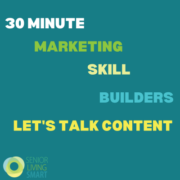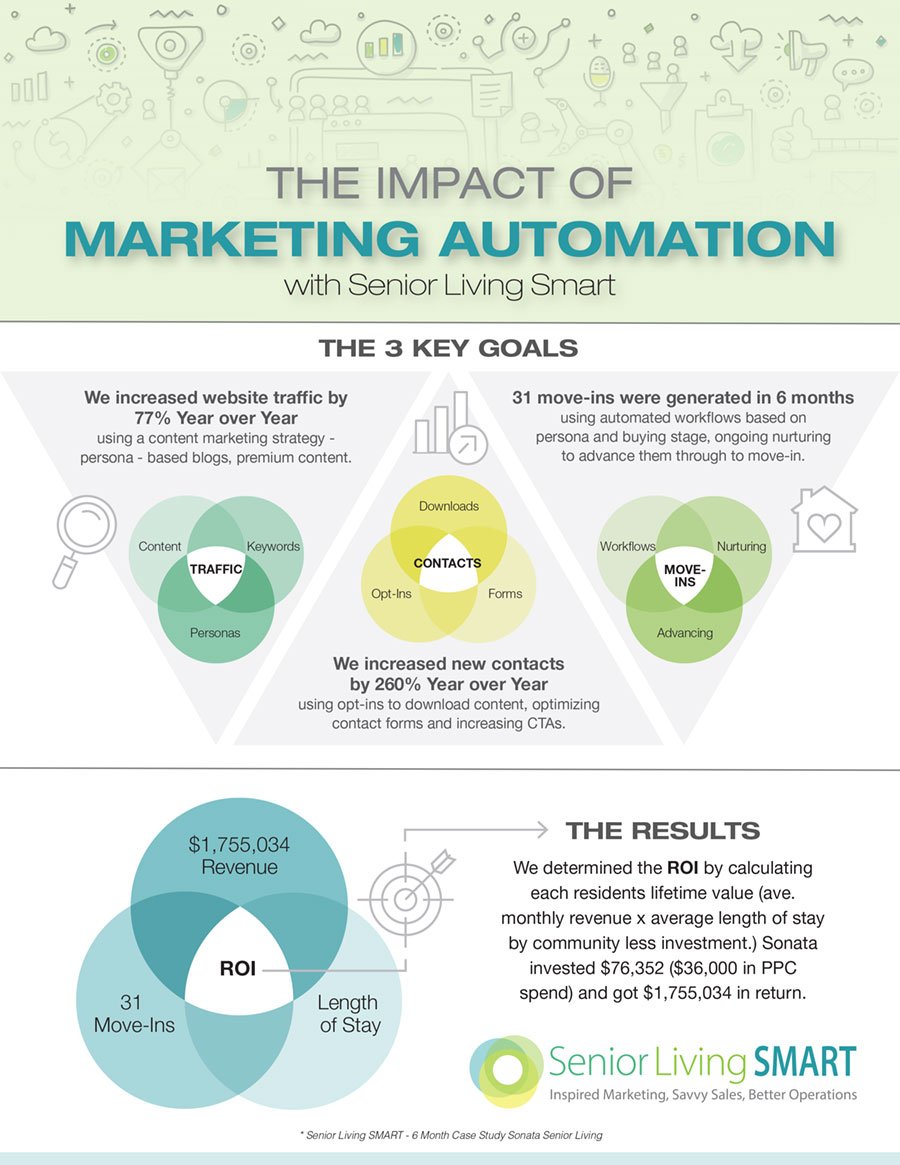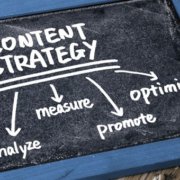A few years ago, Eat This, Not That! was published to provide advice on how to replace unhealthy food choices with better alternatives.
Today, we’re sharing Ask This, Not That! – a guide for VPs of marketing and the C-Suite to measure the effectiveness of their digital marketing for senior living.
We recommend focusing on five critical metrics:
1. Digital Marketing for Senior Living: Conversions, Not Traffic
Don’t be distracted by website traffic. Instead, focus on what matters: conversions. As in traffic that actually converts into customers.
Invest your budget in creating more website conversion points rather than simply increasing traffic. Here are some ideas for doing exactly that:
- Blog more. Websites that publish new blog posts every week get 3.5 times more leads per month.
- Create premium content such as guides, e-books, tool kits, and infographics. Gate them (put them behind a form) to increase conversions of anonymous visitors to leads.
- Add live chat (like SiteStaff) to respond to prospects’ questions and convert chats to leads and tours.
- Make your website experiential with interactive surveys (Roobrik), room planners (Design Floor Plans), and financial calculators.
Note: Marketing teams should be able to quantify how many leads have converted to inquiry calls (using call tracking, such as Marchex), scheduled tours, and brochure/ pricing requests.
Question to bring up during your next meeting with marketing and sales: “What are the conversion rates for each marketing channel?”
2. Digital Marketing for Senior Living: Not All Leads Are Created Equal
Asking how many leads are generated is the wrong question. A better question to ask is this: How many leads are Marketing Qualified Leads (MQLs) vs. Sales Qualified Leads (SQLs)? You should have a way of measuring both.
- MQLs are early stage leads in research mode. They engage by reading blogs, downloading guides and brochures, and checking out pricing. Or maybe they are trying to self-qualify, but they’re not ready for a sales pitch. They want to be left alone until they are ready!
- SQLs, on the other hand, are in the consideration and decision stages. These leads will opt into calls-to-action, such as “schedule a tour” and “speak with an advisor.” As such, it’s imperative that the sales team has immediate access to these leads.
Having technology that can apply lead scoring to quickly sort leads into MQLs and SQLs is critical in today’s competitive “speed to the lead” environment. And your marketing team should be able to provide the number of MQLs and SQLs in the pipeline.
Question to bring up during your next meeting with marketing and sales: “How do we identify MQLs vs SQLs so the sales team is working with the prospects most likely to convert?”
3. Digital Marketing for Senior Living: Nurturing the “Not Ready” Leads
Pressure on getting move-ins TODAY has created dangerous behaviors of focusing exclusively on urgent (high acuity) leads rather than building a healthy pipeline.
Each sales team member can realistically manage only about 10 active leads. So what do you think is happening with the other 200+ leads languishing in the CRM? Not much beyond maybe a few perfunctory “just checking in” follow-up calls to make an activity quota.
Marketing teams should have a strategy to keep the “not ready” leads engaged. Marketing automation (we use HubSpot) takes rote and repetitive tasks off the sales team’s plates and uses automated workflows to ensure that “not ready” leads are given resources while being exposed to your brand. Over time, this fosters trust and encourages the lead to advance to an SQL as they continue on their decision-making journey.
The best part? You can customize these strategic “drip campaigns” to each prospect based on their expressed interests and website behaviors. Links to blogs, premium content, newsletters, and event invitations keep prospects engaged until they are “ready.”
Question to bring up during your next meeting with marketing and sales: “What is our strategy to engage, nurture, and convert ‘not ready’ leads?”
4. Digital Marketing for Senior Living: Impact of Third Party Leads
The question most executives ask is “how many leads are in the CRM?” But a better question is this: “How many unique leads are in the database?”
A VP of Sales & Marketing recently told me that 80% of the leads in their CRM were generated from third party lead sources. This is important for two reasons. First, these leads averaged a 3% conversion rate. This means the sales team spends 80% of their time with low conversion opportunities. That leaves them only 20% of their time to work with leads generated from high conversion lead sources, such as friend and family referrals (35% conversion), professional referrals (40% conversion rate), and organic digital lead sources.
Second, these are shared leads – probably with five to seven of your nearest and dearest competitors. So in measuring actual lead volume, third party leads should only count as 1/5th or 1/7th of a lead. Counting third party leads as a unique lead will skew your actual lead volume and lull sales teams into a false sense of security that they have “plenty of leads” in the pipeline.
Question to bring up during your next meeting with marketing and sales: “What’s the lead percentage from each referral source category?”
5. Digital Marketing for Senior Living: It’s All About the ROI
At the end of the day, it is all about ROI. That is the difference between a marketing expense and an investment. You should be able to measure through every marketing channel—digital, paid AdWords and social campaigns, events, and traditional print, radio and TV advertising—the dollars invested and the leads generated in return.
Ideally, you should have a way to follow every lead through their journey and measure the cost per lead, cost per qualified lead, cost per tour, and cost per move-in. At Senior Living SMART, we help our clients go even further by calculating the resident lifetime value. Our clients provide the average length of stay and average rate by lifestyle for each community so we can accurately calculate the ROI of all marketing efforts.
Question to bring up during your next meeting with senior living marketing and sales: “What is the ROI of each marketing campaign?”
Need help analyzing your analytics?
As a senior living marketing agency, we can help you understand the metrics that matter most. Get in touch!
How to Boost Occupancy & Lead Generation Through Inbound Marketing. Learn how we helped one client experience over 1200% ROI across 10 communities in fewer than four months! In this case study, track the growth of 10 communities using marketing automation, and view measurable results with reported ROI.






